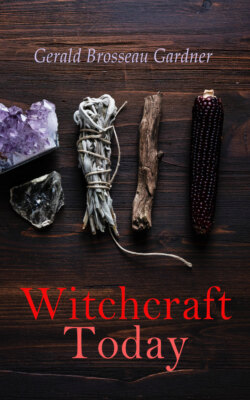Читать книгу Witchcraft Today - Gerald Brosseau Gardner - Страница 4
Preface
ОглавлениеBy
Dr. Margaret Murray
Formerly Assistant Professor in Egyptology at University College, London
In this book Dr. Gardner states that he has found in various parts of England groups of people who still practise the same rites as the so-called 'witches' of the Middle Ages, and that the rites are a true survival and not a mere revival copied out of books. In his easy pleasant style he gives a sketch of similar practices in ancient Greece and Rome, and his wide personal experiences in the Far East enable him to show that there are many peoples, whether in the Far East or in Great Britain, who still perform acts of worship to the Almighty Giver of Life according to ancient ritual. Though the ritual of Europe is now consonant with modern civilisation, the feeling which underlies both the primitive and the civilised is the same: gratitude to the Creator and hope for the Constance of His goodness.
Personal worship may take any form, but a group of persons worshipping together always devise some form of ritual, especially when the worship takes the form of a dance. The ritual dance, whether pet formed as an act of worship or as the expression of a prayer, is characterised by its rhythmic action. The prayer-dance is usually for the increase of food, and therefore imitates in stylized form the movements of the animals or the growing of the plants for which increase is desired. The worship dance is even more rhythmic than the prayer.
All the movements are rhythmic, and the accompaniment is a chant or performed by percussion instruments by which the rhythm is strongly marked. The rhythmic movements, the rhythmic sounds, and the sympathy of numbers all engaged in the same actions, induce a feeling of exhilaration, which can increase to a form of intoxication. This stage is often regarded by the worshippers as a special divine favour, denoting the actual advent of the Deity into the body of the worshipper. The Bacchantes of ancient Greece induced intoxication by drinking wine, and so making themselves one with their God.
Dr. Gardner has shown in his book how much of the so-called 'witchcraft' is descended from ancient rituals, and has nothing to do with spell-casting and other evil practices, but is the sincere expression of that feeling towards God which is expressed, perhaps more decorously though not more sincerely, by modern Christianity in church services. But the processional dances of the drunken Bacchantes, the wild prancings round the Holy Sepulchre as recorded by Maundrell at the end of the seventeenth century, the jumping dance of the mediaeval 'witches', the solemn zikr of the Egyptian peasant, the whirling of the dancing dervishes, all have their origin in the desire to be 'Nearer, my God, to Thee', and to show by their actions that intense gratitude which the worshippers find them selves incapable of expressing in words.
